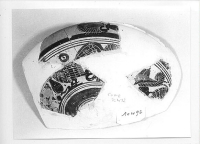


cut
An item at Louvre
Decoration: interior (net, 2); plant motif (lotus flower, palmette, several, above, net, in exergue, above); sphinx (2, plant motif, on, head, 1, confronted) flanking the handle; palmette on basin (in the middle); animal zone (between, net, 3); rooster (2, confronted, on either side of, lotus bud); sphinx (2, confronted); rooster (?, tail); in the field; circle (dotted) Condition of the work: three joined fragments give the upper left part of the center of the basin; the fourth non-joined fragment gives the lower part of the body of the sphinx on the left; concretions; wear of the surface of the vase (non-joined fragment and one of the roosters from the outside of the basin); alteration of the slip (inside the basin) Restoration: reattached (the three joined fragments); completed (part of the basin so as to integrate the non-joined fragment)
Department of Greek, Etruscan and Roman Antiquities
An exhibit at Louvre
The Department of Greek, Etruscan, and Roman Antiquities is home to a collection of artworks representing the Greek, Etruscan, and Roman civilizations; it illustrates the art of a vast area encompassing Greece, Italy, and the whole of the Mediterranean basin, and spans the period from Neolithic times (4th millennium BC) to the 6th century AD.




